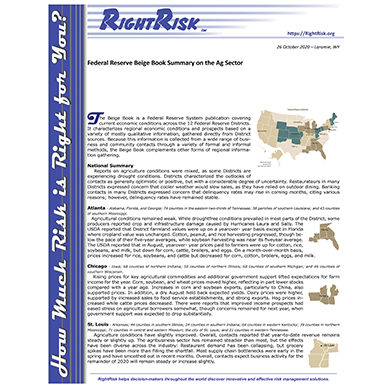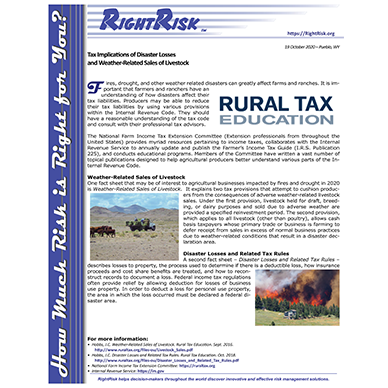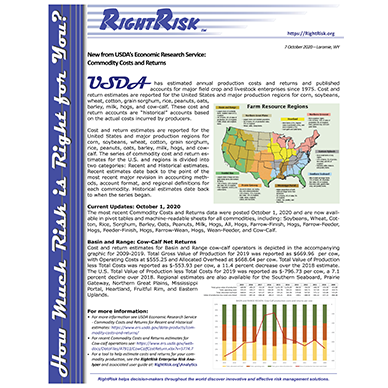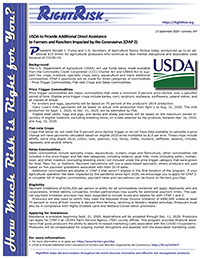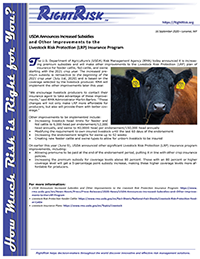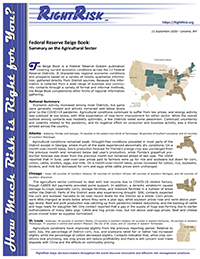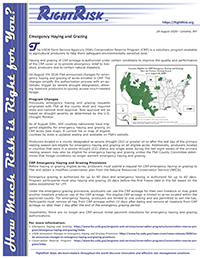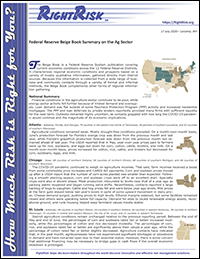The Beige Book is a Federal Reserve System publication covering current economic conditions across the 12 Federal Reserve Districts. It characterizes regional economic conditions and prospects based on a variety of mostly qualitative information, gathered directly from District sources. The latest update was posted Wednesday December 2nd.
Category Archives: RightRisk News Release
Farm Financial Outlook Improves: Federal Reserve – Bank of Kansas City Ag Credit Survey
The outlook for agricultural credit conditions in the Tenth District improved in the third quarter alongside increases in commodity prices and the announcement of additional government aid. After dropping sharply in the second quarter due to disruptions associated with the COVID-19 pandemic, the prices of most agricultural commodities began to recover in the summer months. . .
Federal Reserve Beige Book Summary on the Ag Sector
The Beige Book is a Federal Reserve System publication covering current economic conditions across the 12 Federal Reserve Districts. It characterizes regional economic conditions and prospects based on a variety of mostly qualitative information, gathered directly from District sources. The latest update was posted October 21st.
Tax Implications of Disaster Losses and Weather-Related Sales of Livestock
Fires, drought, and other weather related disasters can greatly affect farms and ranches. It is important that farmers and ranchers have an understanding of how disasters affect their tax liabilities. Producers may be able to reduce their tax liabilities by using various provisions within the Internal Revenue Code. They should have a reasonable understanding of the tax code and consult with their professional tax advisors. . .
USDA Economic Research Service: Commodity Costs and Returns
USDA has estimated annual production costs and returns and published accounts for major field crop and livestock enterprises since 1975. Cost and return estimates are reported for the United States and major production regions for corn, soybeans, wheat, cotton, grain sorghum, rice, peanuts, oats, barley, milk, hogs, and cow-calf. These cost and return accounts are “historical” accounts based on the actual costs incurred by producers.
USDA to Provide Additional Direct Assistance to Farmers and Ranchers Impacted by the Coronavirus (CFAP 2)
President Donald J. Trump and U.S. Secretary of Agriculture Sonny Perdue today announced up to an additional $14 billion for agricultural producers who continue to face market disruptions and associated costs because of COVID-19.
The U.S. Department of Agriculture (USDA) will use funds being made available from the Commodity Credit Corporation (CCC) Charter Act and CARES Act to support row crops, livestock, specialty crops, dairy, aquaculture and many additional commodities. CFAP 2 payments will be made for three categories of commodities – Price Trigger Commodities, Flat-rate Crops and Sales Commodities.
USDA Announces Increased Subsidies and Other Improvements to the Livestock Risk Protection (LRP) Insurance Program
THE U.S. Department of Agriculture’s (USDA) Risk Management Agency (RMA) announced it is increasing premium subsidies and will make other improvements to the Livestock Risk Protection (LRP) plan of insurance for feeder cattle, fed cattle, and swine starting with the 2021 crop year. The increased premium subsidy is retroactive to the beginning of the 2021 crop year (July 1st, 2020) and is based on the coverage selected by the livestock producer.
Federal Reserve Beige Book Summary on the Agricultural Sector
The Beige Book is a Federal Reserve System publication covering current economic conditions across the 12 Federal Reserve Districts. It characterizes regional economic conditions and prospects based on a variety of mostly qualitative information, gathered directly from District sources. The latest update was posted September 2nd.
Emergency Haying and Grazing
The USDA Farm Service Agency’s (FSA) Conservation Reserve Program (CRP) is a voluntary program available to agricultural producers to help them safeguard environmentally sensitive land.
Haying and grazing of CRP acreage is authorized under certain conditions to improve the quality and performance of the CRP cover or to provide emergency relief to livestock producers due to certain natural disasters.
Previously emergency haying and grazing requests originated with FSA at the county level and required state and national level approval. Now approval will be based on drought severity as determined by the U.S. Drought Monitor.
Federal Reserve Beige Book Summary on the Ag Sector
The Beige Book is a Federal Reserve System publication covering current economic conditions across the 12 Federal Reserve Districts. It characterizes regional economic conditions and prospects based on a variety of mostly qualitative information, gathered directly from District sources. The latest update was posted July 15th.


